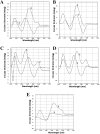Tight DNA-protein complexes isolated from barley seedlings are rich in potential guanine quadruplex sequences
- PMID: 32110488
- PMCID: PMC7034378
- DOI: 10.7717/peerj.8569
Tight DNA-protein complexes isolated from barley seedlings are rich in potential guanine quadruplex sequences
Abstract
Background: The concept of chromatin domains attached to the nuclear matrix is being revisited, with nucleus described as a set of topologically associating domains. The significance of the tightly bound to DNA proteins (TBP), a protein group that remains attached to DNA after its deproteinization should be also revisited, as the existence of these interactions is in good agreement with the concept of the topologically associating domain. The work aimed to characterize the DNA component of TBP isolated from barley seedlings.
Methods: The tight DNA-protein complexes from the first leaves, coleoptiles, and roots of barley seedlings were isolated by purification with chromatography on nitrocellulose or exhaustive digestion of DNA with DNase I. Cloning and transformation were performed using pMOSBBlue Blunt Ended Cloning Kit. Inserts were amplified by PCR, and sequencing was performed on the MegaBace 1000 Sequencing System. The BLAST search was performed using sequence databases at NCBI, CR-EST, and TREP and Ensembl Plants databases. Comparison to MAR/SAR sequences was performed using http://smartdb.bioinf.med.uni-goettingen.de/cgi-bin/SMARtDB/smar.cgi database. The prediction of G quadruplexes (GQ) was performed with the aid of R-studio library pqsfinder. CD spectra were recorded on a Chirascan CS/3D spectrometer.
Results: Although the barley genome is AT-rich (43% of GC pairs), most DNA fragments associated with TBP were GC-rich (up to 70% in some fractions). Both fractionation procedures yielded a high proportion of CT-motif sequences presented predominantly by the 16-bp CC(TCTCCC)2 TC fragment present in clones derived from the TBP-bound DNA and absent in free DNA. BLAST analysis revealed alignment with different barley repeats. Some clones, however, aligned with both nuclear and chloroplast structural genes. Alignments with MAR/SAR motifs were very few. The analysis produced by the pqsfinder program revealed numerous potential quadruplex-forming sites in the TBP-bound sequences. A set of oligonucleotides containing sites of possible GQs were designed and ordered. Three of them represented the minus strand of the CT-repeat. Two were derived from sequences of two clones of nitrocellulose retained fraction from leaves and contained GC-rich motifs different from the CT motif. Circular dichroism spectroscopy revealed profound changes in spectra when oligonucleotides were incubated with 100 mM KCl. There was either an increase of positive band in the area of 260 nm or the formation of a positive band at 290 nm. In the former case, changes are typical for parallel G-quadruplexes and, in the latter, 3 + 1 structures.
Discussion: The G-quadruplexes anchor proteins are probably involved in the maintenance of the topologically associated domain structure.
Keywords: Barley; Deproteinisation-resistant DNA-protein complexes; G-quadruplexes; GC-rich DNA.
©2020 Sjakste et al.
Conflict of interest statement
Nikolajs Sjakste and Marion Roeder are Academic Editors of PeerJ.
Figures

Similar articles
-
Development-dependent changes in the tight DNA-protein complexes of barley on chromosome and gene level.BMC Plant Biol. 2009 May 12;9:56. doi: 10.1186/1471-2229-9-56. BMC Plant Biol. 2009. PMID: 19435519 Free PMC article.
-
Distribution of tight DNA-protein complexes along the barley chromosome 1H, as revealed by microsatellite marker analysis.Cell Mol Biol Lett. 2005;10(1):49-59. Cell Mol Biol Lett. 2005. PMID: 15809679
-
Facilitation of a structural transition in the polypurine/polypyrimidine tract within the proximal promoter region of the human VEGF gene by the presence of potassium and G-quadruplex-interactive agents.Nucleic Acids Res. 2005 Oct 20;33(18):6070-80. doi: 10.1093/nar/gki917. Print 2005. Nucleic Acids Res. 2005. PMID: 16239639 Free PMC article.
-
DNA and RNA quadruplex-binding proteins.Int J Mol Sci. 2014 Sep 29;15(10):17493-517. doi: 10.3390/ijms151017493. Int J Mol Sci. 2014. PMID: 25268620 Free PMC article. Review.
-
Human telomere, oncogenic promoter and 5'-UTR G-quadruplexes: diverse higher order DNA and RNA targets for cancer therapeutics.Nucleic Acids Res. 2007;35(22):7429-55. doi: 10.1093/nar/gkm711. Epub 2007 Oct 2. Nucleic Acids Res. 2007. PMID: 17913750 Free PMC article. Review.
Cited by
-
Beyond the Primary Structure of Nucleic Acids: Potential Roles of Epigenetics and Noncanonical Structures in the Regulations of Plant Growth and Stress Responses.Methods Mol Biol. 2023;2642:331-361. doi: 10.1007/978-1-0716-3044-0_18. Methods Mol Biol. 2023. PMID: 36944887
-
Searching for G-Quadruplex-Binding Proteins in Plants: New Insight into Possible G-Quadruplex Regulation.BioTech (Basel). 2021 Sep 22;10(4):20. doi: 10.3390/biotech10040020. BioTech (Basel). 2021. PMID: 35822794 Free PMC article.
-
The Newly Sequenced Genome of Pisum sativum Is Replete with Potential G-Quadruplex-Forming Sequences-Implications for Evolution and Biological Regulation.Int J Mol Sci. 2022 Jul 30;23(15):8482. doi: 10.3390/ijms23158482. Int J Mol Sci. 2022. PMID: 35955617 Free PMC article.
References
-
- Andorf CM, Kopylov M, Dobbs D, Koch KE, Stroupe ME, Lawrence CJ, Bass HW. G-quadruplex (G4) motifs in the maize (Zea mays L.) genome are enriched at specific locations in thousands of genes coupled to energy status, hypoxia, low sugar, and nutrient deprivation. Journal of Genetics and Genomics. 2014;41(12):627–647. doi: 10.1016/j.jgg.2014.10.004. - DOI - PubMed
LinkOut - more resources
Full Text Sources
Research Materials
Miscellaneous

